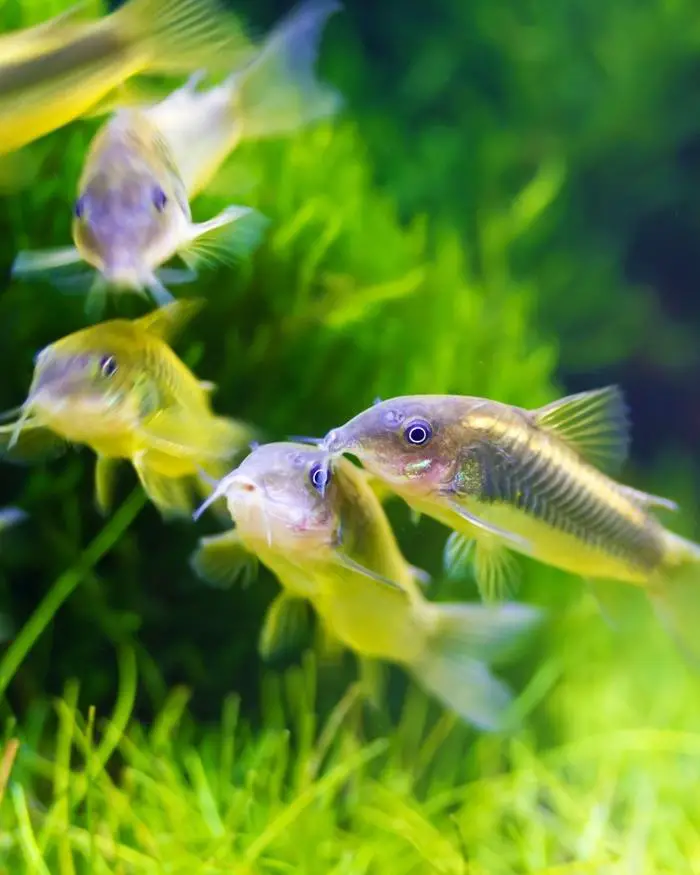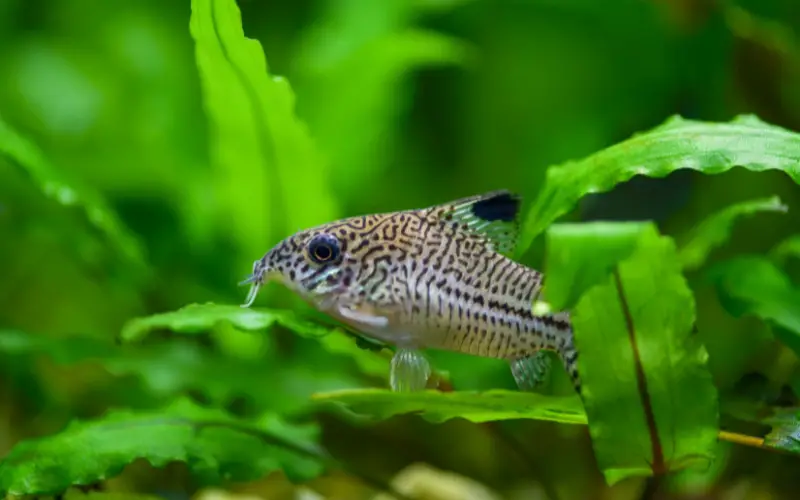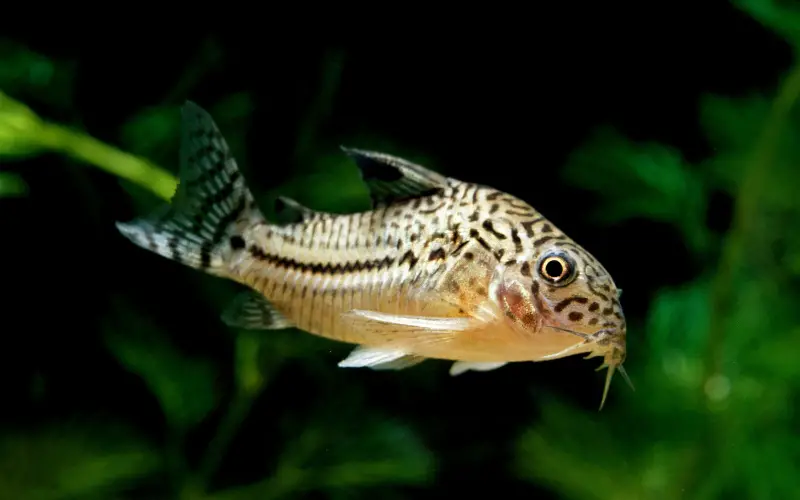Cory catfish, or Corydoras, are popular freshwater aquarium fish that hobbyists widely keep. These small, peaceful catfish are known for their unique behaviors and ability to clean up the bottom of the tank. However, there’s been a longstanding debate in the aquarium community: Do Cory Catfish Need a Bubbler?
While some fish species require an airstone or bubbler to ensure proper oxygen levels in the fish tank, Cory cats can thrive in environments with moderate oxygen levels.
These catfish have a unique adaptation that allows them to gulp air from the surface, which makes them more resilient in low-oxygen conditions.

Do catfish need a bubbler? However, a bubbler can still provide some benefits, such as increased water circulation and preventing stagnant areas.
Ultimately, deciding to use a bubbler in a Cory catfish tank will depend on factors such as tank size, stocking levels, and personal preference.
In this Cory catfish care guide, we will unveil the dark secret behind this question. So, fasten your seatbelts, and let’s dive deep into the aquatic world of Corydoras Catfish.
Table of Contents
ToggleDo Cory Catfish Need a Bubbler to Survive?
Do Corydoras need air pump? Cory catfish do not need a bubbler to survive, but it is recommended. They do not specifically require a bubbler in their tank. However, having good oxygenation in the water is essential for their health.
Cory catfish are bottom-dwelling fish and spend all their time in the lower levels of the aquarium. This means they are less likely to come up to the surface to breathe than other fish.
A bubbler provides aeration to the water, which helps to increase the dissolved oxygen levels. This is especially important for bottom-dwelling fish, as they are less likely to be exposed to oxygenated surface water.

Can Corydoras live without air pump? While corydoras catfish can survive without a bubbler, they are more likely to be stressed and unhealthy if the water oxygen levels are too low. A bubbler can help ensure your cories fish have a healthy and happy environment.
Here are some of the benefits of using a bubbler in a corydoras tank:
- Increased dissolved oxygen levels
- Reduced stress levels
- Improved water quality
- More active and playful fish
If you are trying to decide whether to use a bubbler in your Cory catfish tank, it is always best to err on caution and use one. It is a relatively inexpensive and easy way to improve the health and well-being of your Cory fish.
Understanding Cory Catfish: Who Are They?
Before jumping into the bubbler debate, let’s get to know our aquatic companions better. Corydoras, scientifically known as Corydoras, are a diverse group of freshwater fish originating from South America. These small, friendly fish are cherished for their playful antics and distinctive patterns.
The Many Faces of Cory Catfish
Cory catfish come in various species, each with unique characteristics. From the charming Albino Cory to the striking Peppered Cory, these fish bring a touch of elegance to any aquarium.
Do Corydoras Need to Come Up for Air?
Yes, Corydoras needs to come up for air. They can breathe oxygen from the water through their gills, but they also have a specialized organ in their intestines that allows them to absorb oxygen from the air. This is called aerial respiration, an adaptation that helps Corydoras survive in low-oxygen environments.
Corydoras typically gulp air from the surface of the water every few minutes. However, the frequency of their air gulping can increase if the water oxygen levels are low or they are stressed or excited.
If you see your corydoras gasping at the water’s surface constantly, this is a sign that the water’s oxygen levels are too low. You should take steps to increase the oxygen levels in the tank, such as adding an air stone or expanding the water movement.
Cory Catfish Tank Setup: A Cory’s Aquarium Haven
– The Importance of Oxygen
Do cory catfish like bubblers? In any aquarium setup, ensuring a healthy oxygen level is vital. This is where the concept of bubblers comes into play. Bubblers, powered by air pumps, agitate the water’s surface, facilitating gas exchange and increasing oxygen levels. While this is crucial for many fish species, Corydoras have some unique traits.
– Cory Catfish and Oxygen
Cory catfish have a fascinating adaptation – they can gulp air from the water’s surface. This means that even in setups with low oxygen levels, Corys can survive without much trouble. However, does this mean they don’t need a bubbler? Let’s delve deeper.
– The Bottom-Dwelling Specialists
Cory catfish are natural bottom-dwellers. They spend most of their time scavenging for food and exploring the substrate at the tank’s base. This behavior means they reside closer to the tank’s lower regions, where oxygen levels may be lower.
– The Truth About Bubblers
While Corydoras catfish can tolerate low oxygen levels, providing them with a bubbler is still beneficial. Bubblers not only enhance oxygen levels but also help maintain consistent water conditions. This is crucial for the overall health and well-being of your Corys.
The Care Guide: Ensuring Cory’s Happiness
– Feeding Cory Catfish
Feeding Cory catfish is a straightforward affair. These omnivores enjoy a varied diet that includes sinking shrimp pellets, algae wafers, and live or frozen foods. The key is to ensure they receive a well-balanced diet to thrive.
– Water Quality Matters
Maintaining a healthy tank environment is essential for Cory fish. Regular water changes and a good filtration system are paramount. Remember, Corys are sensitive to poor water quality.
Do Corydoras Like Flow?
Corydoras are bottom-dwelling fish that are native to rivers and streams in South America. They often inhabit areas with moderate to strong currents in their natural habitat. This is because the current helps to keep the water oxygenated and to disperse food particles.
While corydoras can tolerate a wide range of water flow conditions, they generally prefer a moderate to strong current in their aquarium.
This helps to keep them active and healthy. However, it is essential to provide them with some areas in the tank where the current is gentler so that they can rest and avoid being swept away.

Some Corydoras species prefer even stronger currents than others, such as the corydoras paleatus and corydoras habrosus. These species are often found in fast-flowing rivers in their natural habitat.
If you are still determining how much current to provide in your Corydoras tank, it is best to start with a moderate current and then adjust it as needed.
You can monitor your Corydoras’ behavior to see if they seem happy and comfortable. If your Cory catfish hiding or swimming erratically, it may be a sign that the current is too strong.
What to Feed Cory Catfish?
Cory catfish are omnivores, meaning they eat both plants and animals. In the wild, they scavenge for food on the bottom of the tank, eating insects, larvae, worms, and other tiny organisms. In captivity, they might be fed a variety of foods, including:
- Sinking pellets and wafers: These foods are designed explicitly for bottom-feeding fish and are easy for cory catfish to eat. Look for pellets and wafers that are high in protein and contain some plant matter.
- Frozen and live foods: Cory catfish enjoy frozen foods, such as baby brine shrimp, bloodworms, daphnia, and tubifex worms. These foods are a good protein source and can help supplement a diet of sinking pellets and wafers.
- Algae wafers: Algae wafers are a good fiber source and can help keep cory catfish’s digestive system healthy. However, cory catfish should be fed more than algae wafers, as Corydoras catfish require a diet high in protein.
What Do Cory Catfish Like in Their Tank?
Cory catfish are bottom-dwelling fish that are social and active. They like to have plenty of space to swim and explore and places to hide and rest. Here are some specific things that cory fish like in their tank:
- Ample swimming space. Cory catfish requires a tank of at least 20 gallons, with more room for larger species. The tank should also have a good water flow, but not so much that it creates a too-strong current for the fish.
- Soft substrate. Cory catfish have sensitive barbels that can be damaged by sharp substrate. Sand or fine gravel with rounded edges is ideal for these fish.
- Hiding places. Cory catfish like to have places to hide and rest, such as rocks, driftwood, and aquatic plants. You can also provide them with terracotta pots or other ceramic objects they can burrow into.
- Schooling buddies. Cory catfish are social fish and should be kept in groups of at least six individuals. This will help them feel more secure and reduce stress.
- Clean water. Cory catfish are sensitive to water quality and need a clean tank with stable water parameters. Be sure to do regular water changes and test the water regularly.
Here are some additional things that you can do to make your Cory catfish tank more enjoyable for your fish:
- Add live plants. Live plants provide cover, hiding places, and oxygen for the fish. They also help to filter the water and keep it clean.
- Add a school of other peaceful fish. Corys catfish can be kept with other mild fish, such as tetras, rasboras, and danios.
- Provide a variety of food. Cory catfish are omnivores and enjoy a diet of both meaty and plant-based foods. You can feed them commercial sinking pellets and frozen or live foods such as daphnia, baby brine shrimp, bloodworms, and algae wafers.
By providing your cory fish with the above conditions, you can help them to thrive and live long and happy lives.
Commonly Asked Questions about Corydoras Natural Habitat (FAQs)
Can Cory catfish live with other fish species?
Cory catfish are peaceful and can coexist with various fish species, provided they share similar water parameters.
What is the lifespan of a Cory catfish?
Cory catfish can live for several years if given proper care, with some species living up to a decade.
How do I keep the tank clean with Cory catfish?
Regular water changes and a good filtration system are essential to maintaining a clean Corys tank.
Are Cory catfish suitable for beginners?
Yes, Cory catfish are hardy and an excellent choice for beginner aquarists.
What is the natural habitat of Cory Catfish?
Cory catfish are native to South America and predominantly found in the Amazon River basin.
How many Cory Catfish should I keep together?
Keeping Cory catfish in groups of at least 6 individuals is recommended, as they are social fish and thrive in a shoaling environment.
Where does Cory Catfish prefer to live in the tank?
Corydoras catfish are bottom-dwelling fish, so they prefer to reside near the tank substrate.
What type of aquarium setup does Cory Catfish need?
Cory catfish prefer a well-maintained aquarium with clean tank water. They thrive in a planted tank setup with lots of hiding spots.
Can Cory Catfish eat other fish?
Cory catfish are peaceful bottom feeders and do not harm other fish in the tank. However, it’s always a good idea to monitor their behavior.
Are Cory Catfish hardy fish?
Yes, Corydoras are known to be hardy fish that can adapt well to various aquarium conditions.
How often should I feed my Corydoras Catfish?
Feeding your Corydoras a small amount of food once or twice a day is recommended. They are omnivorous and can eat various foods such as pellets, flakes, and frozen/live foods.
How can I keep my Cory Catfish healthy?
To keep Cory catfish healthy, provide a clean and well-maintained tank, ensure suitable water parameters (such as low ammonia, nitrite, and nitrate levels), and provide a balanced diet.
Are Cory Catfish bottom feeders?
Cory catfish are bottom feeders and primarily scavenge for food that has fallen to the tank substrate.
Does Corydoras need air pump?
Do Cory catfish need an air pump? Corydoras do not necessarily need an air pump, but it is recommended for aquariums that are heavily stocked or have low water surface agitation. An air pump helps to oxygenate the water and prevent oxygen levels from dropping too low.
What temperature do Cory catfish lay eggs?
Cory catfish typically lay their eggs at water temperatures between 75 to 80 degrees Fahrenheit (24 to 27 degrees Celsius).
Do Cory catfish need oxygen?
Yes, cory catfish need oxygen to survive. They obtain oxygen from the water through their gills, but they also have an auxiliary respiratory organ that allows them to extract oxygen from air. This is why you may see them occasionally darting up to the surface to gulp air.
Can Cory catfish live without air pump?
Cory catfish can survive in a tank without an air pump for short periods, but it is not ideal. An air pump helps to oxygenate the water and prevent oxygen levels from dropping too low, which can stress or even kill the fish.
Final Thoughts
So, do Cory catfish need a bubbler? In conclusion, while Corydoras catfish are adaptable and can survive without a bubbler, providing one is a gesture of care that can significantly enhance their quality of life. These charming bottom-dwellers bring a unique charm to any home aquarium and are relatively easy to care for. So, to ensure your Corys catfish thrive and flourish, consider adding a bubbler to their aquatic haven.
You might also like
- Why Do Cory Catfish Swim to the Top? (7 Causes & Solutions)
- How to Tell If Corydoras Are Happy & why it matters?
- Do Cory Catfish Need a Heater in Tank: (5 Essential Tips!)
- How Often to Feed Cory Catfish: 5 Tips for Explosive Growth!
- Can Corydoras Live Without Air Pump: Here’s How They Do It!
- Cory Catfish Glass Surfing: (Reasons & 5 Rapid Solutions)
- Do Cory Catfish Clean the Tank Effectively: (Find Out Now!)
- The Fascinating Albino Corydoras Catfish Behavior (Revealed!)




